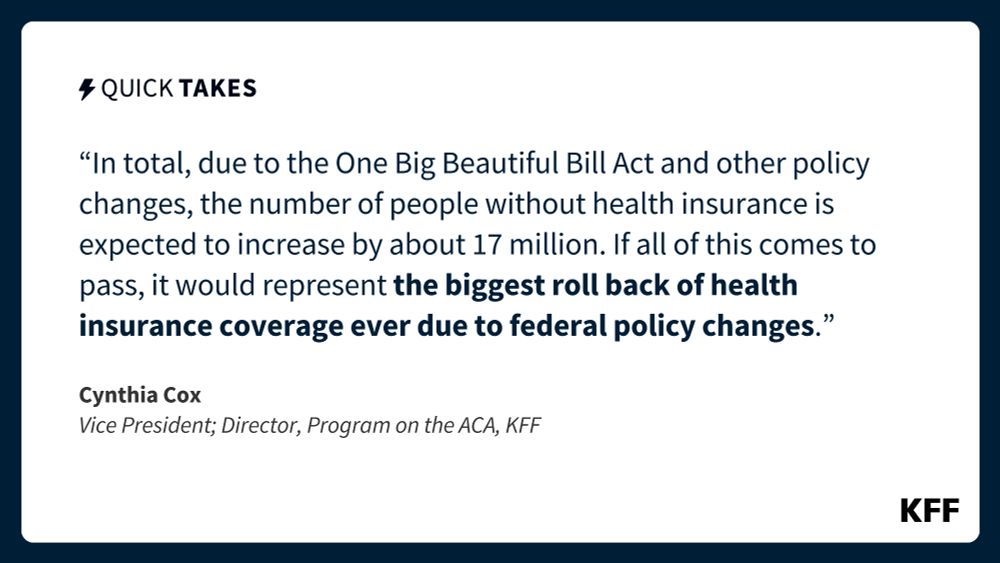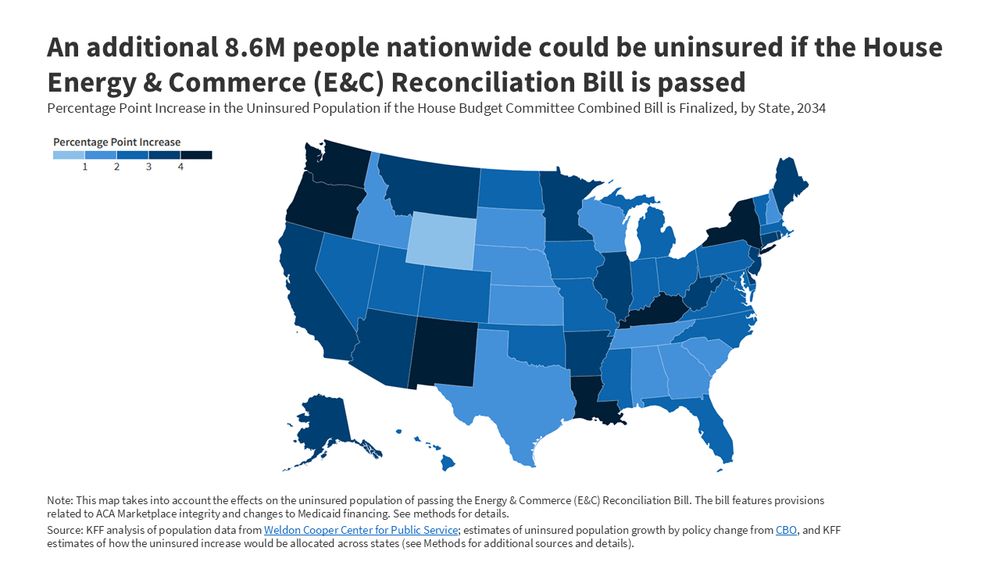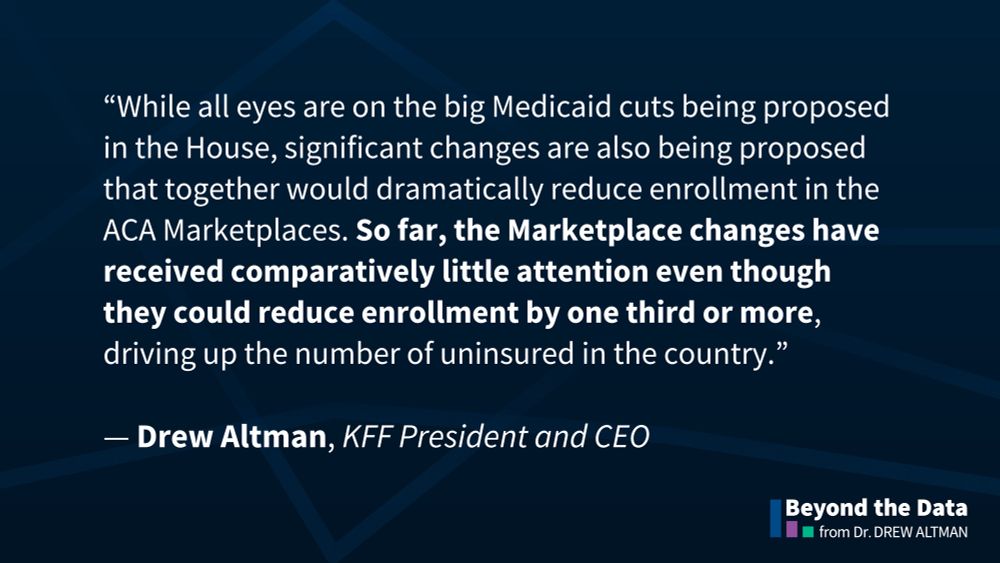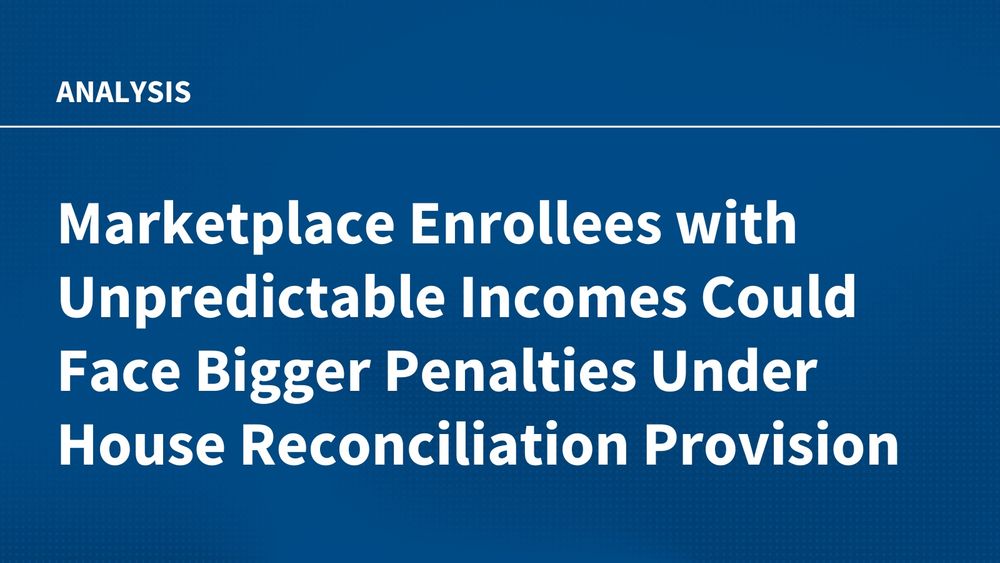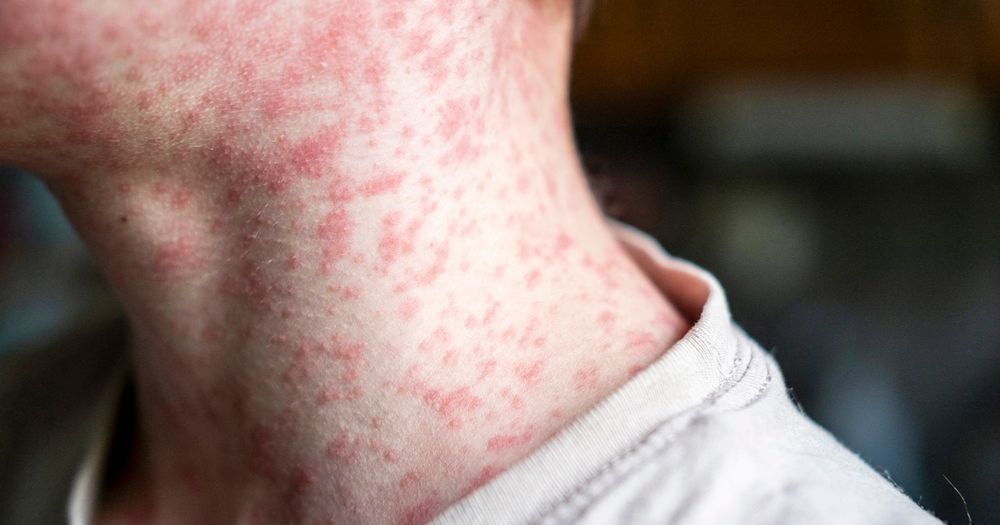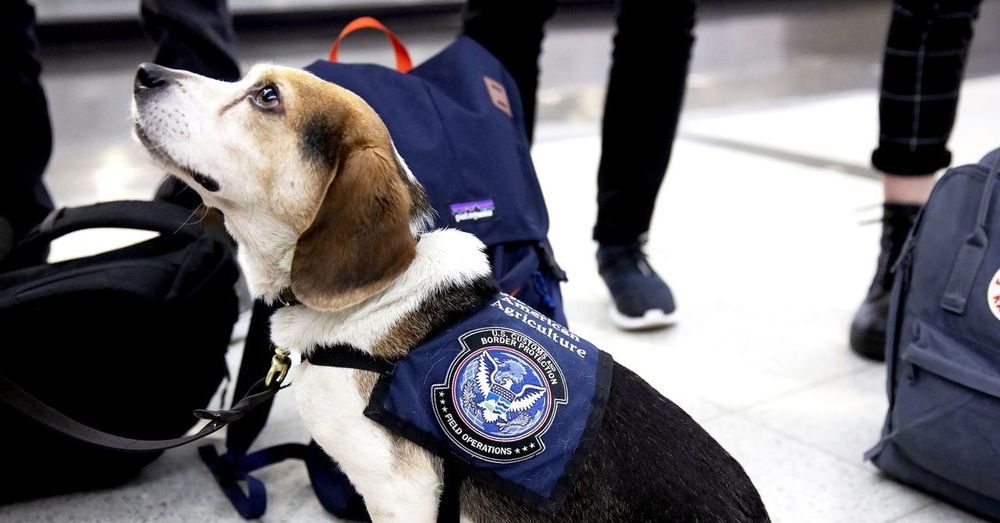
KFF graphic featuring a quote from Cynthia Cox, KFF Vice President and Director of the Program on the ACA. It says, “The amount health insurers charge for coverage on the ACA Marketplaces is rising 26%, on average, in 2026... Most enrollees would face even sharper increases in what they pay if they ACA’s enhanced premium tax credits expire.”
Across all states, benchmark ACA premiums will rise an average of 26% next year, though most enrollees would see sharper increases if the enhanced tax credits expire.
KFF’s Cynthia Cox explains the numbers. #QuickTake https://on.kff.org/3WNhiDz
28.10.2025 23:53 — 👍 16 🔁 13 💬 1 📌 1
The debate over extending the ACA’s enhanced premium tax credits is at the center of the congressional shutdown.
KFF’s @cynthiaccox.bsky.social breaks down what is at stake and what each side is saying.
24.10.2025 17:19 — 👍 9 🔁 4 💬 1 📌 0
If more people switch ACA plans, more people will be double counted.
This would artificially increase the number of “enrollees” who appear to have no claims.
10.10.2025 20:36 — 👍 1 🔁 0 💬 0 📌 0
I’m getting a lot of questions about notices insurers are sending out to ACA/Obamacare enrollees about premiums for next year.
I’m curious to see a notice letter if you have one and want to share. My DMs are open.
@louisenorris.bsky.social @kgmom219.bsky.social
10.10.2025 20:17 — 👍 19 🔁 16 💬 1 📌 0
The EDGE data used to show ACA “enrollees” without claims actually tracks “enrollments,” double-counting people who switch plans.
CMS says this causes a “small” overcount.
But EDGE enrollment totals are about 50% (11+ million) higher than other CMS enrollment data.
10.10.2025 20:16 — 👍 9 🔁 1 💬 1 📌 1

KFF graphic featuring a quote from Cynthia Cox, KFF Vice President and Director of the Program on the ACA. It says, “The enhanced premium tax credits lower the percent of income people have to pay across the board. For subsidized enrollees, what they pay each month is not up to insurers, it’s up to Congress... In other words, when we say premium payments will go up 114%, most of that increase is just based on a formula set by Congress.”
⚡ KFF’s @cynthiaccox.bsky.social explains how Congress can still prevent the vast majority of ACA enrollees from facing higher premium costs — even if insurer premiums are already locked in. #QuickTake https://on.kff.org/46V968K
08.10.2025 13:13 — 👍 15 🔁 4 💬 2 📌 2
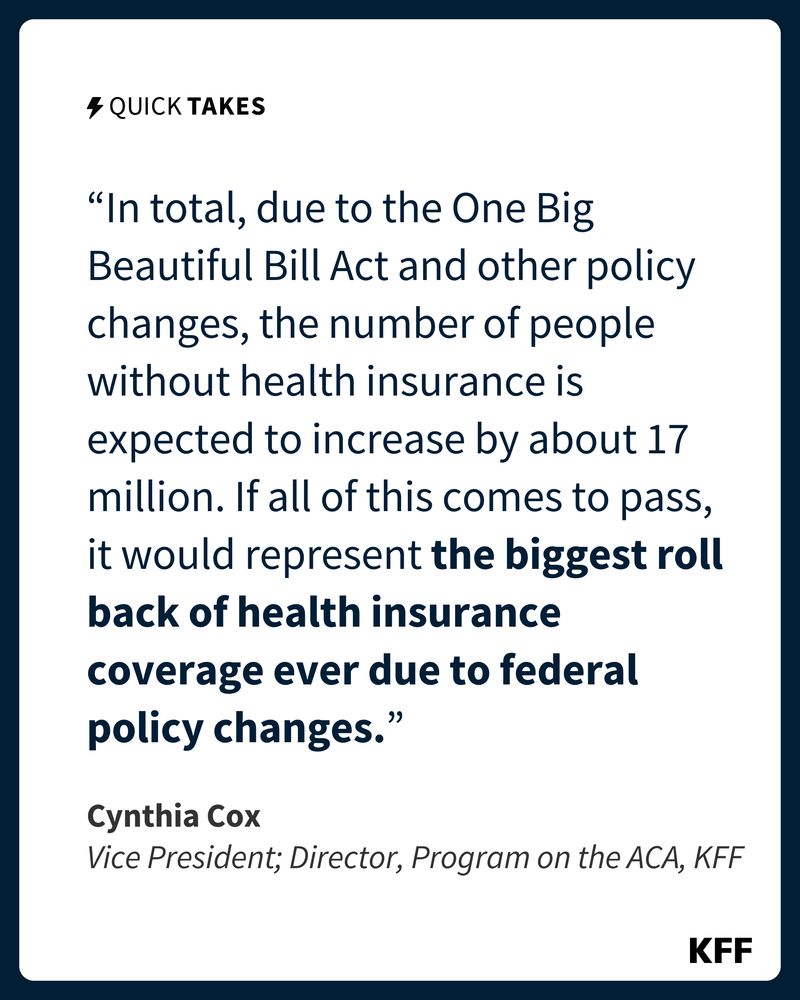
KFF graphic featuring a quote from Cynthia Cox, KFF Vice President and Director of the Program on the ACA. It says, “In total, due to the One Big Beautiful Bill Act and other policy changes, the number of people without health insurance is expected to increase by about 17 million. If all of this comes to pass, it would represent the biggest roll back of health insurance coverage ever due to federal policy changes.”
⚡ KFF’s @cynthiaccox.bsky.social explains how millions of people are expected to lose health insurance coverage over the next decade with cuts to Medicaid and the ACA in the reconciliation bill, as well as other ACA changes not in the bill. #QuickTake on.kff.org/3GrJ9V5
01.07.2025 15:18 — 👍 29 🔁 15 💬 1 📌 2
Medicaid cuts put lives and communities at risk.
“Without Medicaid… I would be dead.”
Home care. Rural hospitals. Coverage for 100,000+ kids — all threatened.
The CBO says 16 million more could be uninsured by 2034.
The stakes couldn’t be higher.
30.06.2025 12:37 — 👍 9 🔁 13 💬 2 📌 1
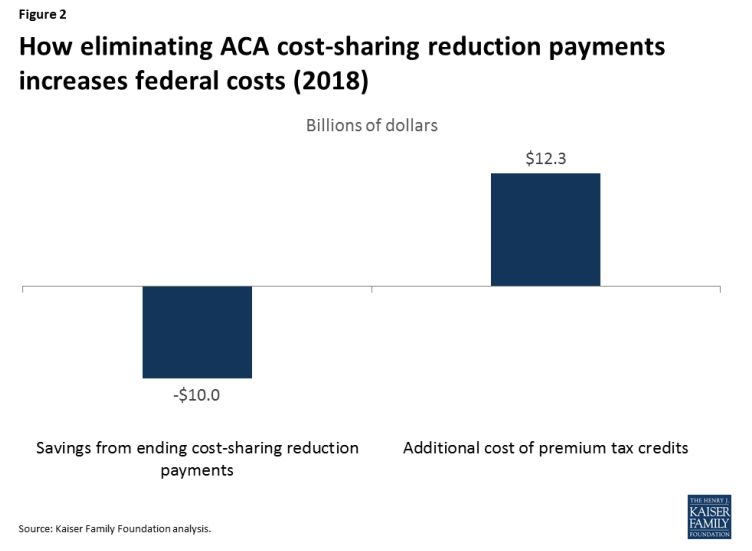
If you want to understand how appropriating funding for ACA cost-sharing subsidies saves the government money and decreases premium assistance for enrollees, check out this analysis from 8 years ago by me and
@cynthiaccox.bsky.social.
www.kff.org/affordable-c...
22.05.2025 15:59 — 👍 24 🔁 8 💬 1 📌 0
Also unlike the ACA repeal debate, I am unsure how widely the projected loss of coverage for ~10 million people is known. The ACA debate was clearly healthcare focused. This time, I'm seeing lots of articles referencing the "budget bill," "policy bill," "tax bill," etc. The stakes are less clear.
21.05.2025 22:02 — 👍 38 🔁 21 💬 2 📌 0
Covered California (CA’s ACA marketplace) is projecting that 30% of people enrolled through Covered California will lose/drop marketplace coverage as a result of Republican cuts.
Again, I ask, where is the health care industry lobby?
This is 600,000 fewer marketplace plans in California, alone.
20.05.2025 20:55 — 👍 19 🔁 10 💬 3 📌 2
Per this estimate, the GOP bill would leave an extra 38,000 Mainers without health insurance - on top of the current figure of 82,000.
Maine hasn’t seen that number of uninsured people since ~2015 when the economy was much worse and LePage kicked folks off MaineCare.
#mepolitics
20.05.2025 19:33 — 👍 3 🔁 1 💬 0 📌 0
KFF CEO @drewaltman.bsky.social is now on Blue Sky! Follow him for everything health policy @kff.org @kffhealthnews.org
07.05.2025 22:36 — 👍 12 🔁 4 💬 0 📌 0
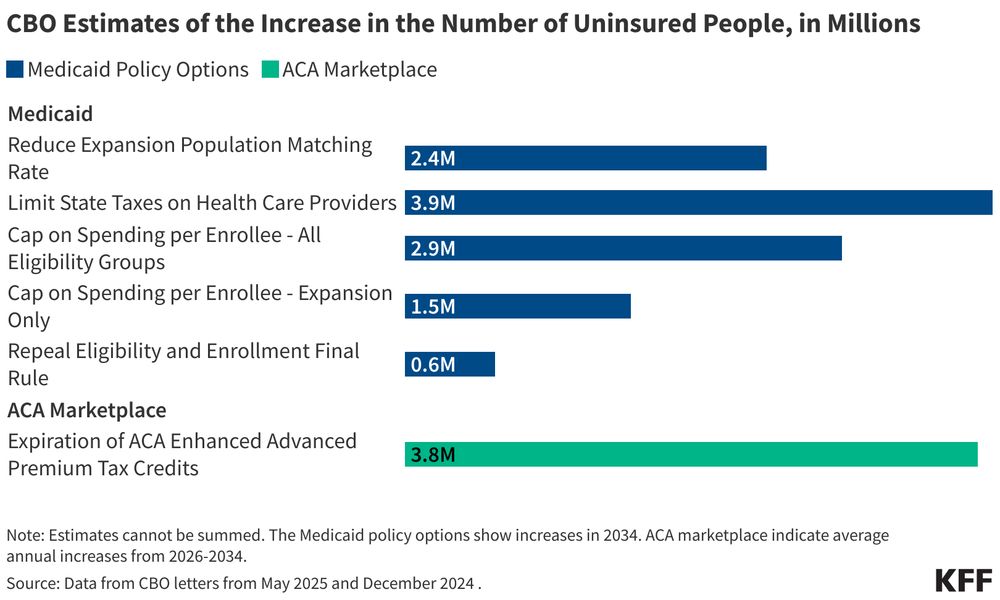
Not necessarily buying these estimates but...of the changes/cuts CBO has analyzed, almost the largest impact on the uninsured--3.8m--comes from the least discussed change, not extending the enhanced ACA tax credits.
07.05.2025 21:46 — 👍 9 🔁 6 💬 0 📌 2
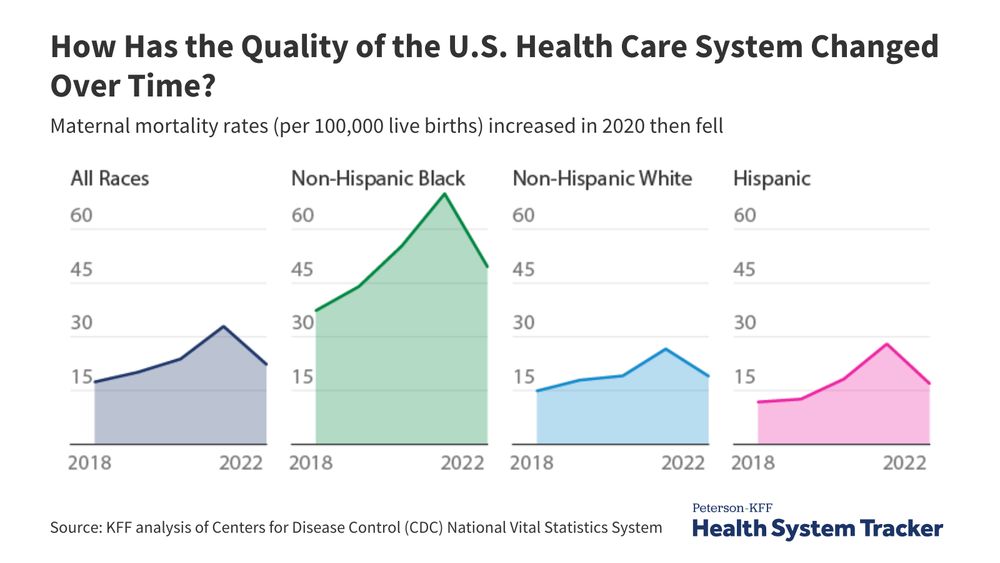
As this study shows, there are many areas of improvement needed in our healthcare system.
How has the quality of the U.S. healthcare system changed over time? www.healthsystemtracker.org/chart-collec... by @lynnemargalit.bsky.social @emmawage.bsky.social @cynthiaccox.bsky.social via @kff.org
01.04.2025 17:43 — 👍 5 🔁 4 💬 0 📌 0
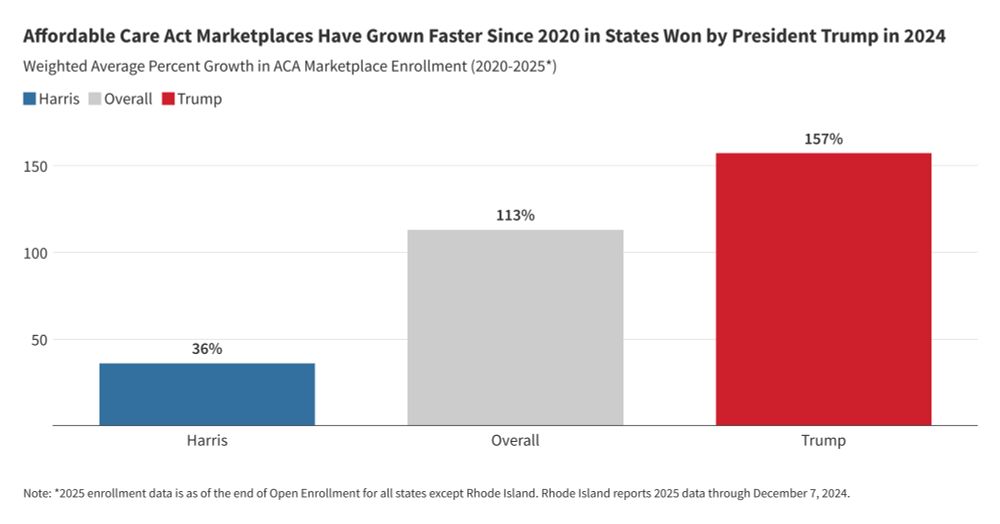
Enrollment Growth in the ACA Marketplaces | KFF
This analysis of enrollment in Affordable Care Act (ACA) Marketplace health plans finds a record 24.3 million people enrolled in 2025, more than double the total in 2020, with most of the growth occur...
(1/2) NEW: Enrollment in the ACA Marketplaces more than doubled since 2020, growing by 12.9M enrollees. Of that increase, 11.4M of the new enrollees (88% of the growth) are from states where President Trump won during the 2024 election. www.kff.org/policy-watch... @cynthiaccox.bsky.social
02.04.2025 16:32 — 👍 16 🔁 12 💬 1 📌 2

the classic windows xp wallpaper with your friend darth the red panda, a red panda wearing a darth vader outfit and with blue sky butterfly wings, flying above
hello ok i am awake what did i miss
tell me every thing
26.03.2025 02:59 — 👍 15674 🔁 1388 💬 1654 📌 573
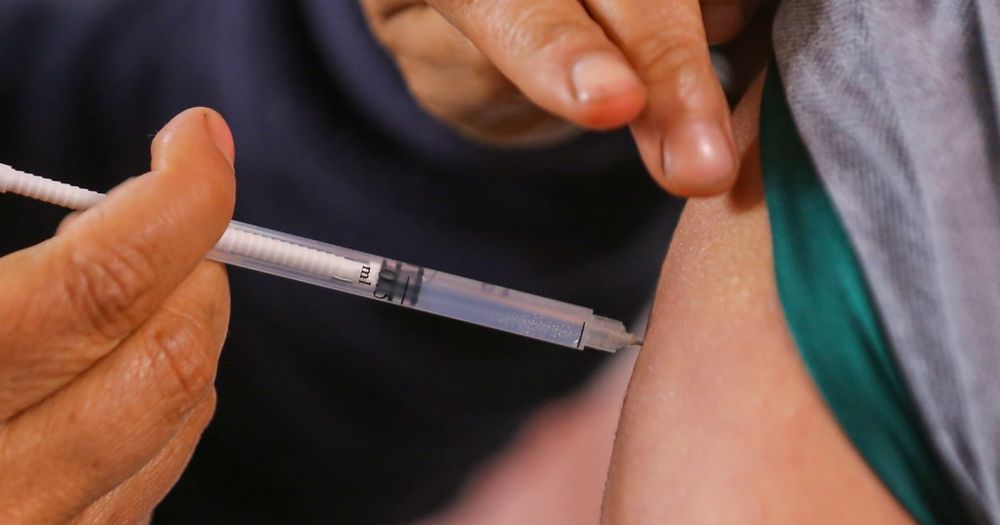
Cancer caused by HPV is increasing in some women in the U.S.
The percentage of women screened for cervical cancer fell, especially in rural areas, as rates of the disease have been edging up among women in their 30s and 40s.
Now that doctors have changed the way they screen for cervical cancer, many women are being told they tested positive for “high-risk” HPV. What does this mean? Does it give you a high risk of cancer? Does it mean the HPV shot failed? Learn more in my latest story!
www.nbcnews.com/health/cance...
24.03.2025 20:44 — 👍 31 🔁 18 💬 1 📌 1
Soooo this flight went fine but on tonight’s return flight to DCA we had to abruptly abort our landing after touching down to avoid crashing into another plane on the runway. After another loop around we landed safely but it was quite scary.
23.03.2025 01:28 — 👍 1943 🔁 430 💬 51 📌 48
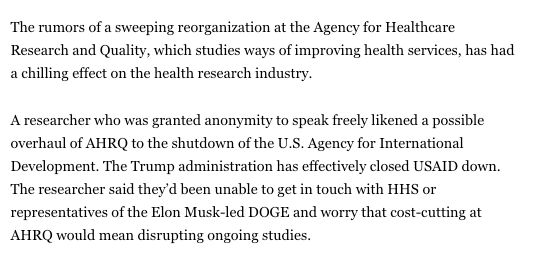
Missed this story last night portending something bad for AHRQ
AHRQ fills a hugely important void in the medical and health care research space: it funds work that doesn't map cleanly to a disease, body part, or special population (e.g., older Americans)
www.politico.com/news/2025/03...
14.03.2025 18:32 — 👍 189 🔁 89 💬 5 📌 14
President, American Cancer Society Cancer Action Network (ACS CAN). Cancer Fighting Advocate. Mom to gang of 4.
Economist at Carnegie Mellon focusing on organizations and incentives, markets, competition, and antitrust, and health care. Formerly at the Antitrust Division, DOJ and at the FTC. Daf Yomi learner. Antitrust, Economics, Talmud puns.
Dean of the Faculty at Harvard T.H. Chan School of Public Health. Epidemiologist by training. Originally from Umbria, Italy. Passionate about sunrises, great food, and soccer. hsph.harvard.edu
Associate Professor in health(care) policy | Rx innovation & access | population health researcher
health policy nerd | sr policy analyst @centeronbudget.bsky.social | formerly CMS and @americanprogress.bsky.social | opinions mine
food service worker by trade, local journalist by profession. addict in recovery.
Chicago Tribune health care business reporter
We're a nonpartisan nonprofit that advocates for evidence-based public policies to reduce the cancer burden for everyone. #CancerAdvocacy
Join us ➡️ FightCancer.org
📍Washington, D.C. and nationwide
Since its inception in 1999, healthinsurance.org has focused on individual & family health insurance with the goal of helping consumers understand coverage options and ultimately make more informed decisions that might make their coverage more affordable.
For over 35 years, the National Academy for State Health Policy has been a nonpartisan organization committed to developing and advancing state health policy innovations and solutions.
Reposts ≠ endorsements
President and CEO of @kff.org; Executive Publisher of @kffhealthnews.org
Journalist, looking for next thing. Bylines all over the place.
Book: NOT A SCIENTIST: How politicians mistake, misrepresent, and utterly mangle science (WW Norton).
Signal: @davelevitan.26
www.davelevitan.com
Sign up: www.gravityisgone.com
"Your Health" columnist for The Wall Street Journal
Super excited to be here and share 98.3% of my DNA w this guy
Reporter @kffhealthnews.org. I write about decisions made by powerful individuals and institutions, and the real-life impact on Americans' health.
Find me on Signal: username rachanadpradhan.83
Pulitzer-sharing journo + author
current gig: head of investigations @GuardianUS
prior gigs: @ICIJorg (Panama Papers, etc.), Associated Press, Center for Public Integrity, Wall Street Journal, Roanoke (Va.) Times
linktr.ee/michaelwhudson
I wrote Economix, a graphic novel explaining the economy, available here: https://shorturl.at/K7WWr
You must of course steer clear of pirated versions, like this one, right here, at this link, one free click away: http://bit.ly/3nGyFnN.
Home to the Schaeffer Center for Health Policy & Economics and the Schaeffer Fellows in Government Service. Transforming policy through rigorous, independent research and close engagement with public and private sector leaders.
✏️: Rural Health Reporter @KFFHealthNews.org
📍: Rapid City
✉️: ariellez@kff.org
🚨 Signal: Zionts_RuralHealthNews.22
😍: Story ideas, outdoors, animals, reading, history, art, gravel+mtn biking
❗️: RT means worth reading/knowing, not agreement






